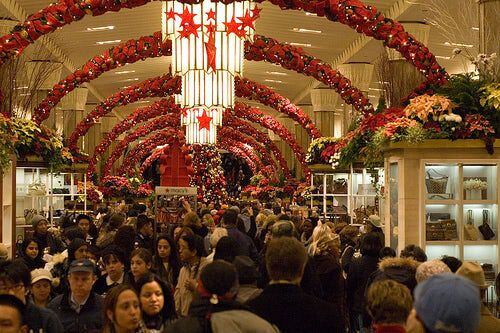Retailers Have Sky-High Expectations for Black Friday. Will Shoppers Show Up? | The Week Ahead, BoF Professional
A Banner Black Friday?
-
Retailers are anticipating strong sales this holiday season as the economy bounces back from the pandemic
-
Some consumers began shopping early, amid warnings that supply chain snarls could delay holiday shipments
-
Prices are rising, particularly on essentials such as gasoline, though so far that hasn’t deterred spending on consumer goods
The pandemic has made people almost nostalgic for Black Fridays of yore, when families gathered around the fireplace to watch viral footage of shoppers trampling each other to grab the last deeply discounted flatscreen TV. Malls, department stores and big box stores are reporting surging foot traffic and are predicting record spending over the long Thanksgiving weekend. The economy is booming, and after missing out on family gatherings last year, some Christmas-themed “revenge shopping” is no doubt in play. Rising inflation and global shipping problems mean shoppers are also having to shell out more to buy the same amount of stuff: Salesforce found online retailers offering 16 percent fewer discounts and 12 percent higher prices on average. Shoppers are also starting their spending earlier than they used to: respondents to a National Retail Federation survey said they’d completed 28 percent of their holiday shopping by early November, compared with 18 percent a decade ago. But despite dire warnings of shipping delays, shortages and fewer promotions this year, there’s been no mass movement away from the last-minute hunt for the perfect gift.
The Bottom Line: More than usual, this holiday season will determine how retailers operate well into the new year. Strong sales would point to a longer period of tight inventories and fatter profit margins. An underwhelming season could snap the industry right back to its pre-pandemic habit of year-round discounts.
Turnaround Takeaways
-
Gap Inc., American Eagle Outfitters and Abercrombie & Fitch report quarterly results this week
-
All three brands have made drastic changes to their businesses over the last few years, to varying degrees of success
-
Abercrombie is furthest along in recapturing its ‘00s glory, as detailed in BoF’s recent case study
Some of America’s biggest mall brands are reporting earnings this week, just ahead of a holiday season that could have a big impact on their futures. The company with the most to prove is Gap Inc., which is coming off a strong run where sales rose at its flagship brand and the first Yeezy products trickled out. Still, questions remain, including about the state of Banana Republic, where chief brand officer Ana Andjelic departed months after debuting her vision for reviving the label. American Eagle is on firmer footing, as its Aerie lingerie brand continues to grow and its main brand is resonating with consumers as well. A pair of recent logistics acquisitions will help shore up the back end as e-commerce plays a bigger role.
Still, executives at both of these companies probably wish they worked at Abercrombie & Fitch right now. The brand has executed a turnaround that jettisoned its problematic early ‘00s vibe and reversed years of slumping sales. The brand now has a reputation for selling stylish, quality clothes, allowing it to charge higher prices than many of its neighbours at the mall. Shares are close to an eight-year high.
The Bottom Line: Success for these companies means adapting what’s good about their brands to new challenges, whether it’s a high-profile collaboration, a new category or a top-to-bottom revamp.
An Unusual Marketing Opportunity
-
House of Gucci hits theatres in the US and UK this week
-
The Kering-owned brand has had little public involvement with the film
-
The stylish trailer, and Lady Gaga’s press appearances, have nevertheless brought attention to the film and the Gucci brand
For many brands, a high-profile movie starring Lady Gaga would be a godsend. For a luxury megabrand like Gucci, it’s a bit of a mixed bag. House of Gucci recaps a dark chapter in the brand’s history, an intra-family fight for control of the company that ended in murder. It will all read as ancient, very stylish history to most fans of the brand today. The family’s involvement with the brand bearing its name ended in the early 1990s; today it’s owned by Kering, a discreet (compared with the ‘80s-era Gucci clan, at least) luxury conglomerate.
Kering hasn’t engaged much with the movie publicly, though the inclusion in the cast of Jared Leto, an Alessandro Michele muse, and Salma Hayek, wife of Kering chief executive François-Henri Pinault, is perhaps a tacit signal of approval. Still, luxury brands prefer their moments in the spotlight to be carefully stage-managed, and the label is presently focused on promoting its “hacker project” with Balenciaga, which is hitting stores around the same time of the film’s release.
The Bottom Line: Kering seems to be getting more comfortable with the promotional value of House of Gucci, as buzz has grown (though the fashion has been praised, early chatter on the merits of the film itself has been more mixed). In recent weeks, the brand has also dressed its stars for a series of premieres around the world. The timing could work out for Gucci which needs to boost growth in a critical Q4 for the brand.
The Week Ahead wants to hear from you! Send tips, suggestions, complaints and compliments to [email protected].


